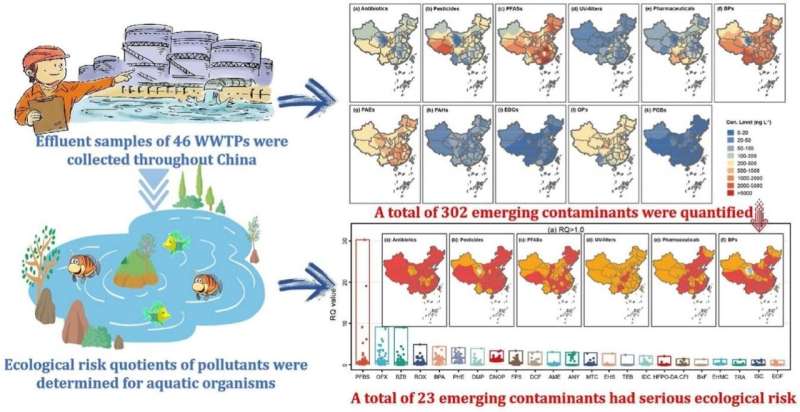This article has been reviewed according to Science X's editorial process and policies. Editors have highlighted the following attributes while ensuring the content's credibility:
fact-checked
proofread
Study reveals ecological threat of trace organic pollutants in China's wastewater effluents

Wastewater treatment plants (WWTPs) are good at cleaning up common pollutants but often miss tiny amounts of other harmful substances, known as trace organic pollutants.
These pollutants are found in very small amounts but can stick around for a long time, build up in living things, and be very harmful to both nature and people's health. They include a variety of dangerous chemicals like bisphenol (used in plastics) and perfluoroalkyl substances (used in non-stick coatings), which are not well-monitored, especially in less developed areas. Even with better technology to detect these substances, there hasn't been a detailed country-wide study.
A pivotal study featured in Eco-Environment & Health has revealed considerable ecological threats from trace organic pollutants found in the effluents of WWTPs throughout China. The researchers conducted a thorough investigation into the presence and ecological dangers of various pollutants in these effluents, offering vital information that enhances our understanding of environmental health and safety.
This extensive study analyzed 302 trace organic pollutants across 46 WWTPs in China, detecting 216 compounds from 11 chemical classes. Advanced techniques like HPLC-MS/MS and GC–MS/MS were employed to quantify pollutants, revealing perfluoroalkyl substances (PFASs) and bisphenol analogs (BPs) as major contributors, accounting for 59% of total pollution.
The ecological risk was assessed using the Risk Quotient (RQ) method, identifying 119 contaminants with significant ecological risks, and 23 demanding immediate attention due to high RQ values. The findings highlighted a stark regional disparity in pollutant concentrations and risks across China.
Guanghua Lu, the lead researcher, emphasized, "Our study is a wake-up call highlighting the presence and risks of overlooked trace organic pollutants in WWTP effluents. It underlines the urgent need for more comprehensive monitoring and stricter regulatory measures."
This thorough study highlights the critical need for focused removal of pollutants, enhancement of treatment technologies, and implementation of stricter regulations to address the ecological dangers presented by trace organic pollutants in WWTP effluents.
It advocates for a balanced strategy that combines technological advancements with rigorous regulatory enforcement to ensure the protection of aquatic ecosystems and public health.
The research supplies essential data that aid environmental managers and policymakers in identifying key contaminants for targeted control in WWTP effluents. By emphasizing the necessity of advanced pollutant removal methods and advocating for more stringent environmental regulations, this study plays a pivotal role in promoting the safeguarding of our natural water resources and the well-being of communities.
More information: Jianchao Liu et al, Unveiling the existence and ecological hazards of trace organic pollutants in wastewater treatment plant effluents across China, Eco-Environment & Health (2023). DOI: 10.1016/j.eehl.2023.09.006
Provided by Nanjing Institute of Environmental Sciences, MEE





















